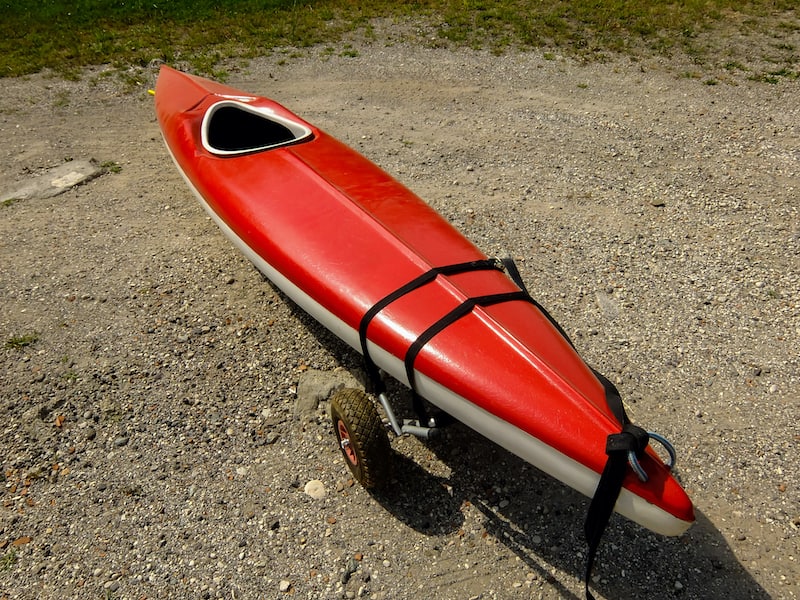Are you tired of hauling your kayak? If your launch spots require a lot of overland carrying, a kayak cart is an excellent investment. These simple carts are inexpensive and allow you to save trips back and forth. If you’re unable to carry your kayak very far, these handy helpers mean you can explore more paddling spots. With a good-quality cart and a thought-out roof rack system, there’s nowhere you can’t go.
In this post, we’ll cover everything you need to know about how to use a kayak cart the right way.
Why Use a Kayak Cart?

The purpose of kayak carts and trolleys is to reduce your workload and make it easier to get your kayak to and from your launch. Everyone transports their kayak different distances, and everyone has a different comfort level in carrying their kayak. If you’ve got to carry your kayak more than a few yards to and from the launch, a cart is a great idea.
Kayaks are pretty awkward to lug around. The wind catches them, and if you’re alone, you have to transport them empty. Perhaps even more worrying is the possibility of dropping the boat or bumping up against something. Fiberglass and some thin plastic boats can easily be chipped or dented.
Finally, a kayak cart can save your back. Kayaking is generally a pretty low-impact sport, but hoisting a large boat around yourself is a good way to pull a muscle or two. A cart reduces the likelihood of an injury.
Here’s a gratifying thought—imagine pulling up to the haulout point after a long, exhausting day of paddling. Every muscle is aching already. Do you really want to carry a kayak to the car? A cart might sound pretty good right about then.
Two Types of Kayak Carts
Kayak carts vary depending on how they are attached to the kayak. Both types look very similar, and nearly all of them have two-wheeled designs. Both types of carts sit toward the center or back half of the kayak. Strap style carts use ratchet straps to secure them to the kayak. Plug-in style carts use the scupper plugs in your boat as connection points.
Strap Style Carts

Strap style carts are the most common that you will see, and they have the advantage of fitting many different types of boats. You can put them under any kayak, canoe, or paddleboard.
Depending on the tires and the sturdiness of the frame, they will be rated for different loads. While you can get by with one rated for just your boat’s empty weight, it’s best to buy one even sturdier. Here’s heavy duty cart we recommend.
- Paddling magazine's 2018 winner in the "best transport/storage/launching' Category
- Engineered to transport the heaviest kayaks - up to 450 pounds
- Easy to load and unload the kayak – no kickstand or scupper posts required
Carts make it easy to load all of your gear at the car and then wheel everything to the launch. That means you might be hauling a lot more than just your empty kayak. Coolers full of ice, camping gear, and all sorts of other goodies can mean your kayak weighs a lot which all gets added to the cart.
Strap style carts all feature some sort of cradle that the bottom of your vessel sits in. Then, to keep the cart from sliding one way or another, a strap is used to secure it. If your boat has tie-down points or a coaming, you can use those things to make the strap even more secure.
How to Strap Your Kayak to a Cart
The exact procedure for using a cart will vary from one manufacturer to the next. Always follow the instructions that came with your cart. Here’s a general idea of how it works.
Step 1 – Lay your kayak down on the ground next to your kayak cart.
Step 2 – Set up the cart next to the area of the boat you want the cart underneath. This spot will usually be half to two-thirds of the way from the bow to the stern.
Step 3 – Lifting from the stern handle and pivoting the boat on its bow, left it up to sit on the cart. Use a towel under the bow if you’re worried about scratches or are on rough terrain.
Step 4 – Fine-tune the location of the cart under the boat, and then install the strap. Use a hatch, coaming, or tie-down point on the boat to ensure that the strap doesn’t slip forward or back.
Plug In Style Carts
Plug-in style carts are usually made for specific models of kayak, so they are less universal. They only work with sit-on type kayaks, which often have scupper holes in them to drain their cockpits. Here’s one made for Hobie kayaks:
These carts look simpler because they will have pipes that insert into the self-bailing scupper holes on the bottom of the kayak. That system is manageable, but it means that it only works on boats with the same size scupper holes in the same places.
Some carts have a universal design, with poles that swing for varying widths of boat. As long as the pole diameter fits inside the scupper holes, these carts will work with any boat that has scuppers. The problem with these designs is that they are more likely to be flimsy. How the poles lock in place needs to be very secure.
Setting up a plug-in style cart is a little more awkward, too. These carts don’t stand up on their own, so wrestling the kayak up and onto the poles takes a little doing. Remember, the cart is trying to roll every which way, and you’re lifting from the heaviest point of the kayak.
How to Plug In Your Kayak to a Cart
Each cart works a little differently, so refer to the instructions that came with it for the specific procedure you should use.
Step 1 – Lay your kayak out on the ground and find the rear-most two scupper holes.
Step 2 – Flip your kayak onto its side. You can hold it in place with one hand, but it might be easier to lean it against your car or a tree.
Step 3 – Take the cart and insert the poles into the scupper holes. You’ll have to hold it in place as you roll your kayak back over.
Step 4 – Depending on the cart, you might need to add a bungee cord or strap to keep it in place as you right the kayak. Once the kayak is sitting on the cart, some will need a strap, and others will be secure enough to tow.
Conclusion
Kayak carts are great tools if you need to move your boat. They save you work, reduce your workload, and can save you from a backache.
But best of all, they give you the confidence to explore a little farther. Any barrier to exploration you can remove is a good thing.


